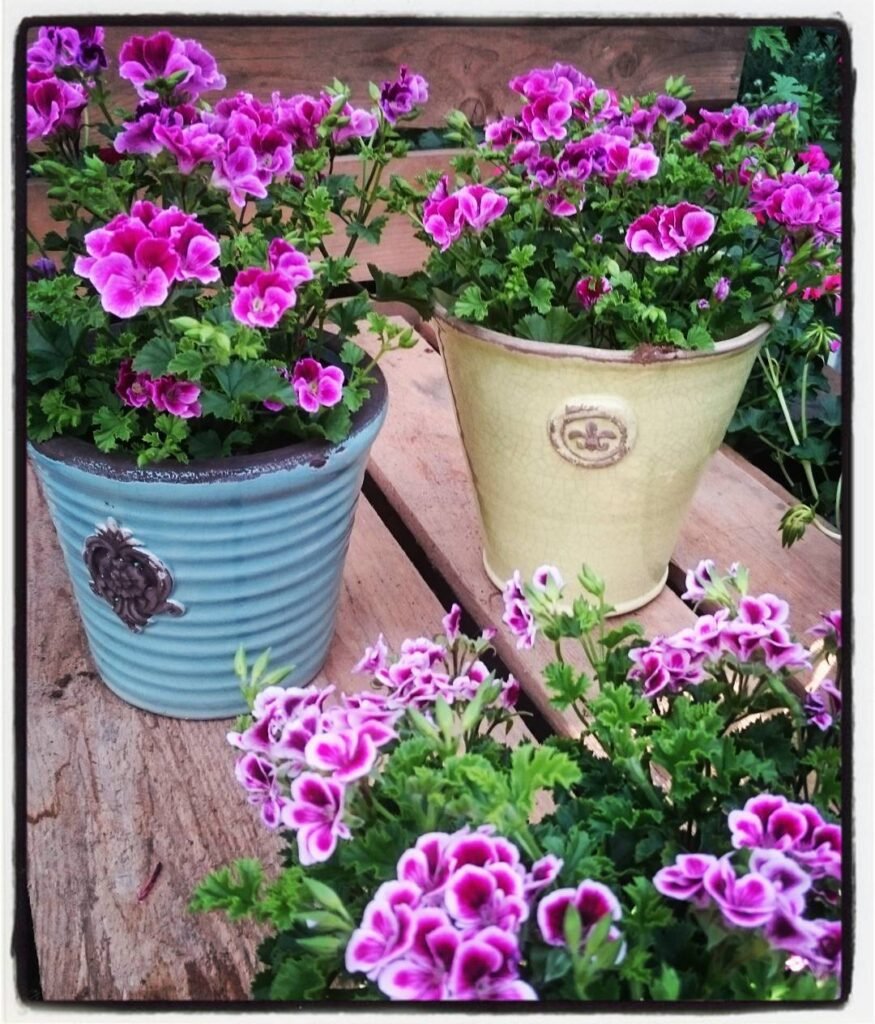If you’re looking for a plant that not only adds beauty but also fills the air with a delightful lemon scent, then Pelargonium crispum, commonly known as lemon-scented geranium or lemon geranium, is the perfect choice. With its fan-shaped leaves and pale pink flowers, this tender evergreen perennial has become a beloved addition to gardens and windowsills across the United Kingdom.
But the benefits don’t stop at the aesthetics and aroma. Along with adding charm and fragrance to your surroundings, lemon-scented geranium also has culinary uses. Its leaves can be used to infuse teas, add flavor to desserts, or create delightful potpourri. So, let’s embark on this journey together and unlock the secrets of growing and enjoying the remarkable Pelargonium crispum.
Appearance of Pelargonium Crispum

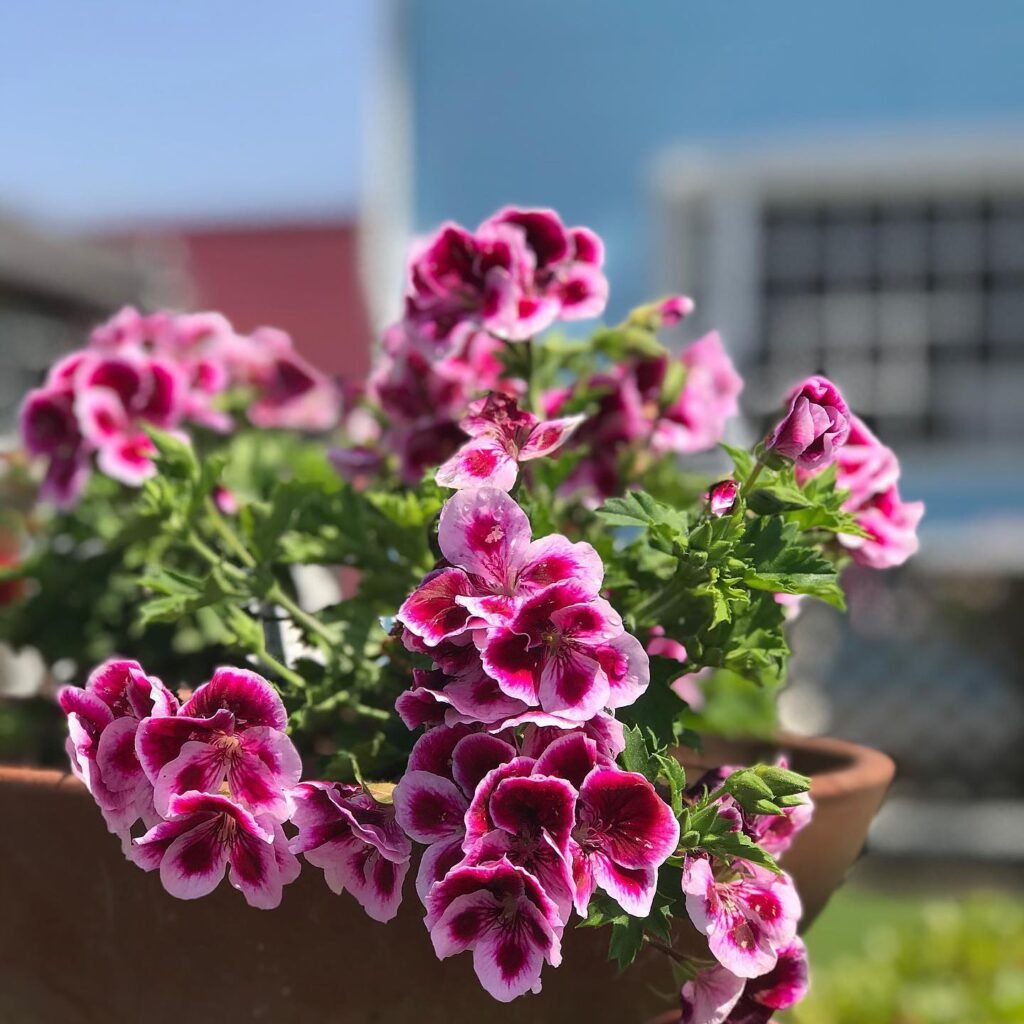
I’m enchanted by Pelargonium crispum, affectionately known as the lemon-scented geranium or lemon geranium. This charming plant boasts fan-shaped, crinkly leaves that release a delightful lemon fragrance, infusing a sense of refreshment wherever it’s placed. The leaves, a vibrant mid-green hue, bring a lively splash of colour to any garden or perch on a windowsill.
The lemon-scented geranium reaches a modest height and spread of about 0.5 meters each, embodying the essence of compactness and versatility. Though it does grace us with pale pink single flowers from spring through to autumn, its main allure lies in its luxuriant foliage and captivating scent, rather than its floral display. For someone new to gardening, this plant offers not just a visual treat but a sensory experience, making it a joyous addition to any green space.
 Pelargonium crispum, the lemon-scented geranium, is often used in cakes and jams for a subtle citrus flavour. Its leaves, when bruised, release a lemon scent that’s both refreshing and soothing, adding an unexpected twist to culinary delights.
Pelargonium crispum, the lemon-scented geranium, is often used in cakes and jams for a subtle citrus flavour. Its leaves, when bruised, release a lemon scent that’s both refreshing and soothing, adding an unexpected twist to culinary delights.
Light Requirements for Lemon-scented Geranium
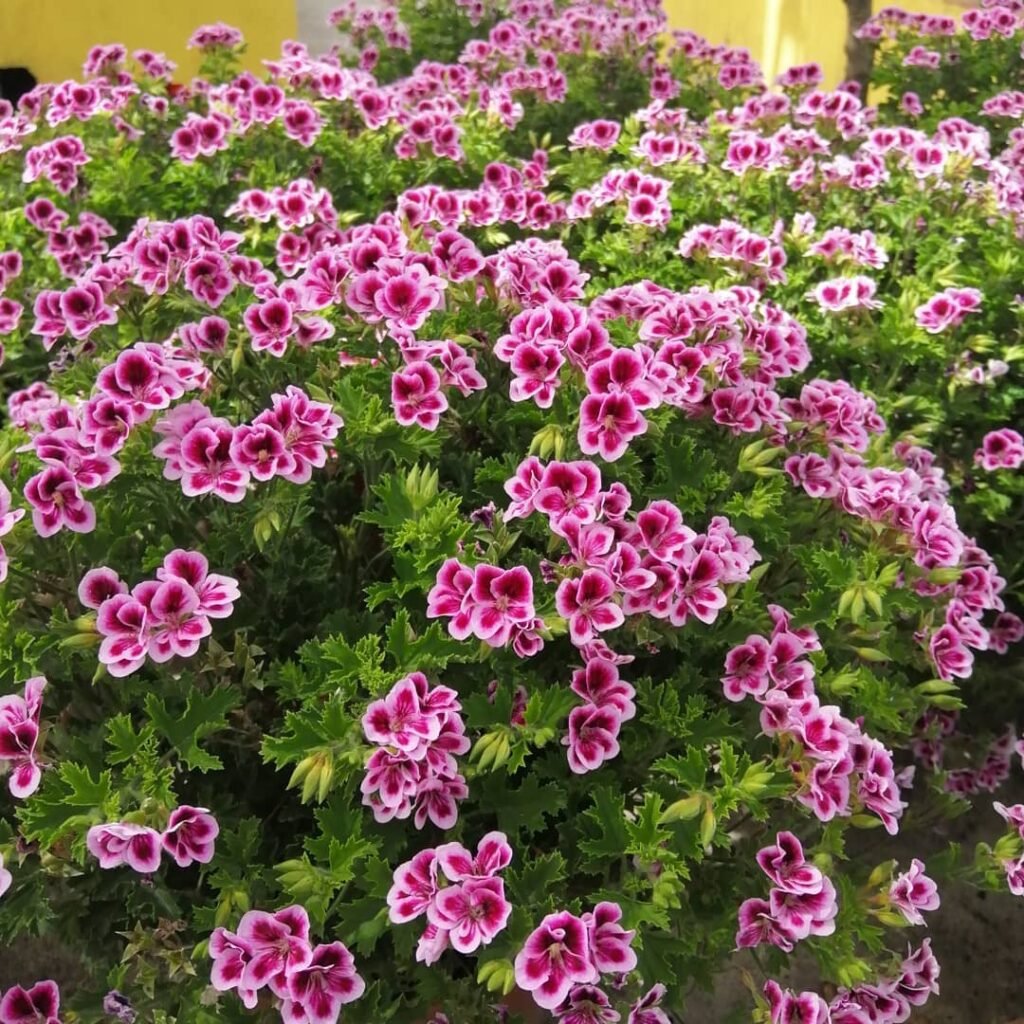

Cultivating your Pelargonium crispum, also fondly referred to as the lemon-scented geranium or lemon geranium, requires a keen understanding of its need for sunlight. This aromatic plant revels in spots bathed in full sun to partial shade. For it to truly flourish, a bright spot offering a generous 4 to 6 hours of sunlight daily is ideal. Yet, in particularly hot climates, it’s wise to shield your plant from the harsh midday sun to avoid the leaves becoming scorched or the plant dehydrating.
Positioning your lemon-scented geraniums in your garden or on a windowsill that catches plenty of light will ensure they get the nourishment they need from the sun. It’s essential to find a spot that provides a good balance between ample sunlight and protection against intense heat. By doing so, you’ll not only encourage robust growth but also enjoy the rich, lemony fragrance that makes the lemon-scented geranium such a joy to have around.

Watering Tips for Pelargonium Crispum
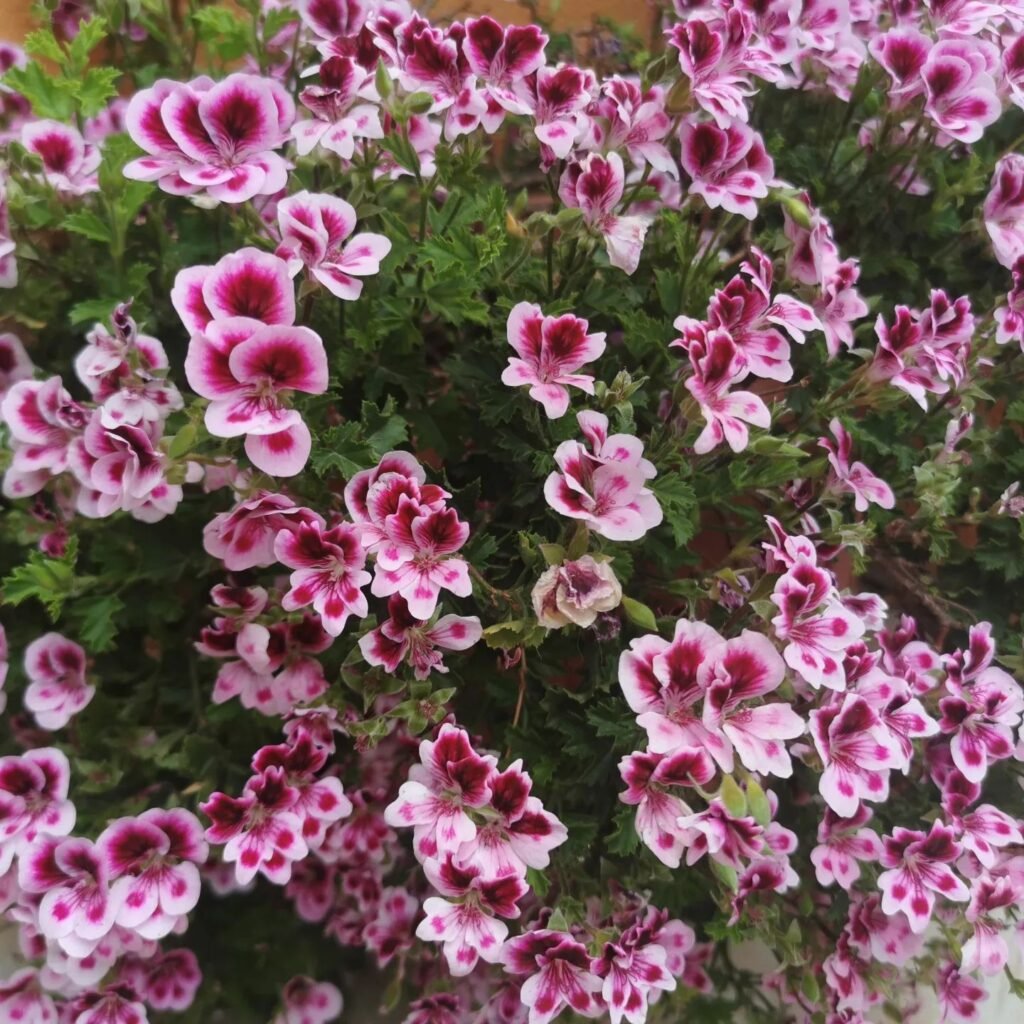

Caring for my Pelargonium crispum, affectionately known as the lemon-scented geranium, means getting the watering just right. Here’s how I ensure this delightful plant remains hydrated and healthy:
- Regular and Even Moisture
- These plants love a steady supply of moisture. I water them deeply to encourage strong root development and ensure they’re getting enough to drink.
- Allow Top Inch of Soil to Dry
- Before giving them another soak, I wait for the top inch of soil to feel dry to the touch. This practice helps me avoid the pitfalls of overwatering and the issues that come with it.
- Avoid Overwatering
- Overdoing the water can spell trouble, leading to root problems and unhappy plants. If I see yellow leaves or detect a musty smell, I know to cut back on the water.
- Adjust Watering in Winter
- As the colder months roll in and my geraniums slow down, I reduce how often I water them, letting the soil dry out a little more than usual to match their reduced needs.
Sticking to these guidelines helps me keep my lemon-scented geranium in top shape, ensuring it continues to fill my space with its zesty fragrance and lush greenery.

Fertilizing and Soil for Lemon-scented Geranium
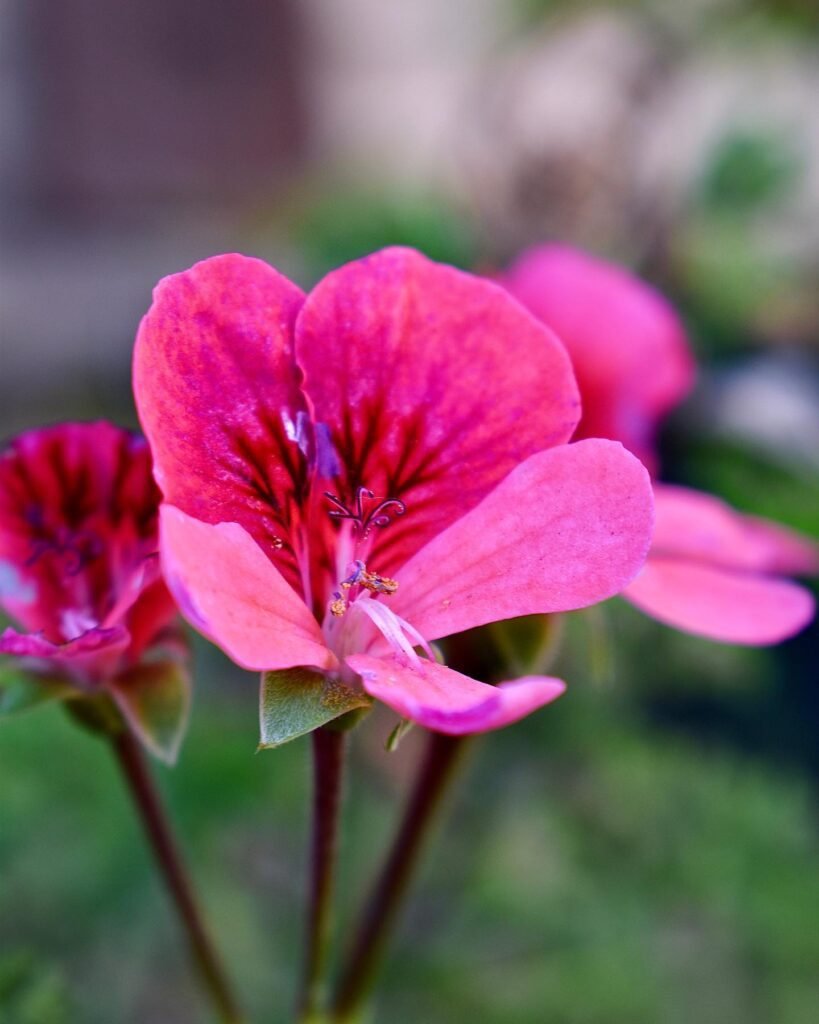
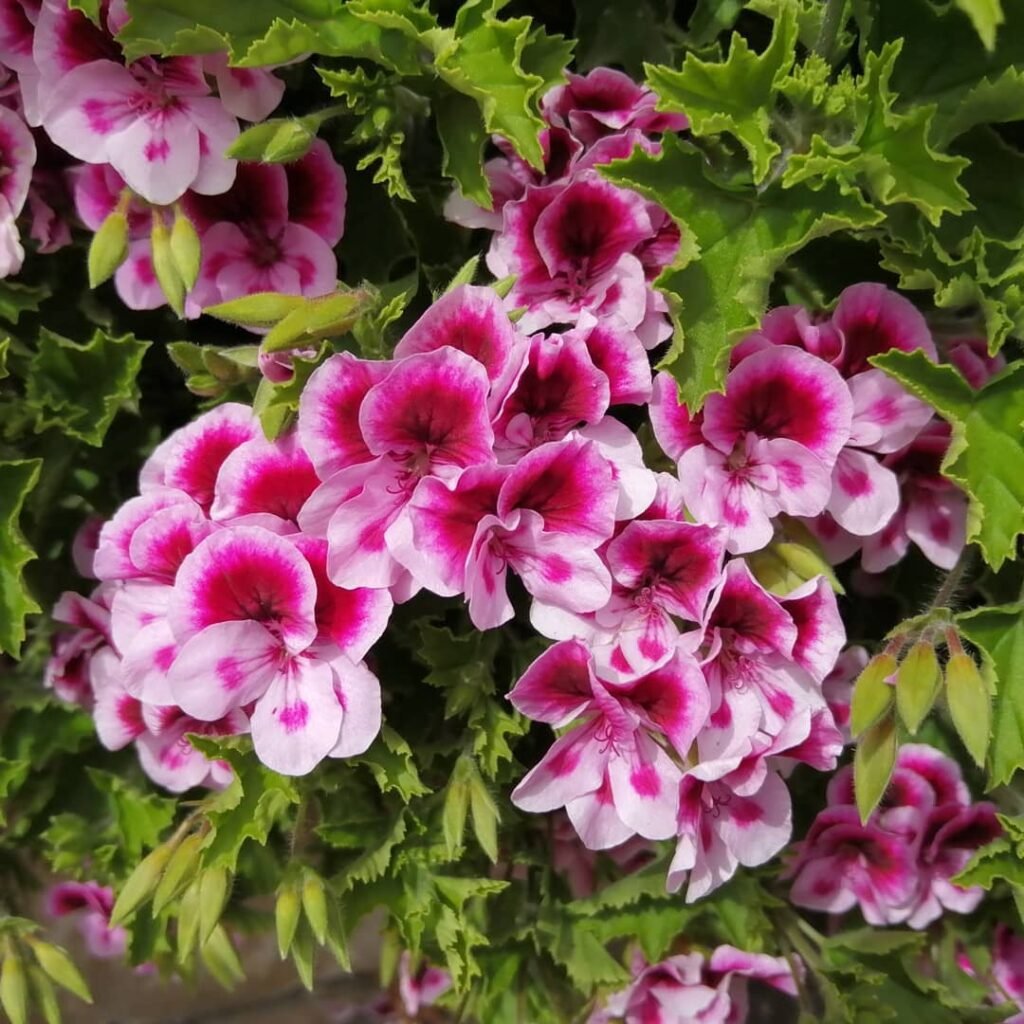
Creating the ideal environment for my Pelargonium crispum, also known as the lemon-scented geranium, means paying close attention to soil and nutrition. Here’s my approach to nurturing this delightfully fragrant plant:
- Soil Requirements for Lemon-scented Geranium
- The key to a thriving lemon geranium plant is well-drained, fertile soil. I aim for a mixture that’s rich in organic matter, combining compost, garden soil, and a sprinkle of perlite or sand. This concoction ensures the soil retains moisture without becoming waterlogged, which is crucial for the health of the plant.
- Ensuring the soil’s pH falls within a neutral to alkaline range is important for optimal growth. I regularly check the pH level to maintain the ideal conditions.
- Fertilizing Lemon-scented Geraniums
- Fertilization is vital during the growing season. I opt for a balanced liquid fertilizer applied every few weeks to supply all the necessary nutrients for my scented geraniums to flourish.
- As the plants start to flower, I switch to a high-potassium fertilizer, which helps promote blooming and enhances the fragrance of the leaves.
- I’m careful to avoid over-fertilizing, as too much can lead to excessive leaf growth, detracting from the plant’s scent. Following the recommended dosage on the fertilizer packaging ensures I strike the right balance.
- It’s also essential to water the plants thoroughly before applying fertilizer. This prevents root burn and ensures the nutrients are effectively absorbed.
Additional Tips:
- Testing the soil pH and adjusting as necessary can make a significant difference in the health and vitality of the lemon-scented geranium.
- Watering before fertilizing is a simple yet effective way to safeguard against nutrient burn and stress to the plant.

Pruning and Maintenance for Pelargonium Crispum
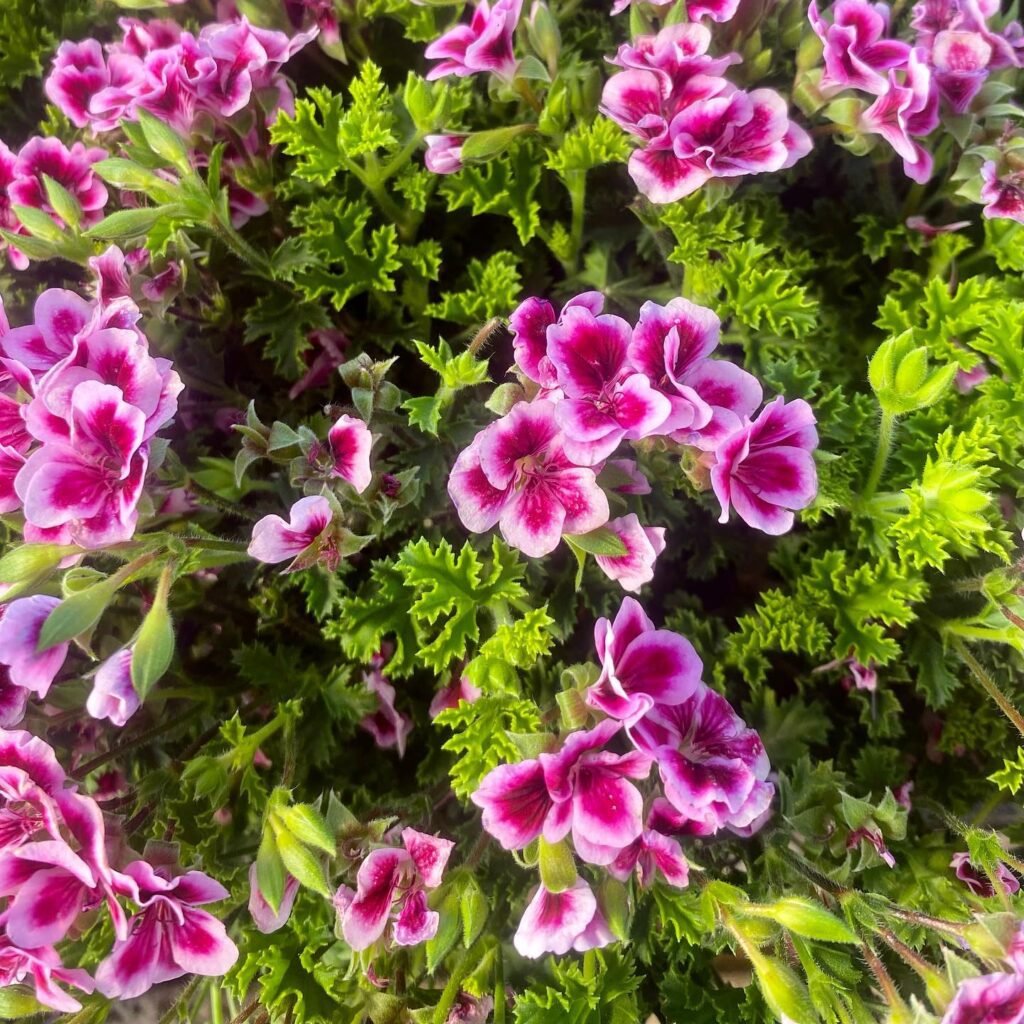
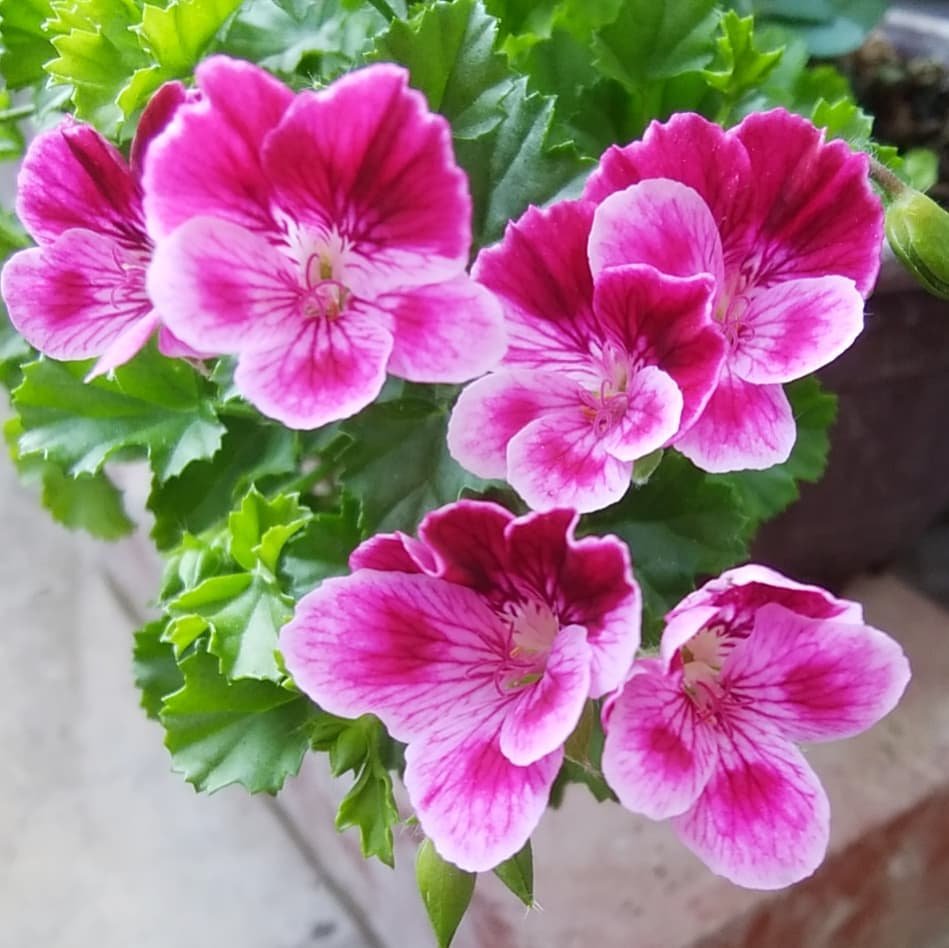
When it comes to pruning Pelargonium crispum, also known as lemon-scented geranium, there are a few simple tips you can follow to keep your plant healthy and promote bushier growth. While pruning is not necessary for their growth, it can be beneficial in maintaining their shape and enhancing their appearance.
In the spring or early summer, you can pinch back the tips of the shoots. This will encourage the plant to branch out and become fuller, resulting in a more compact and bushy appearance. With this simple practice, you can easily shape your lemon-scented geranium to your liking.
Another important aspect of maintenance is deadheading. By carefully removing spent flowers, you can stimulate continuous blooming and ensure that your lemon-scented geranium remains in flower for longer periods. This will also prevent the plant from putting energy into producing seeds, allowing it to focus on flower production.
Regularly inspect your lemon-scented geranium for any yellow or dying leaves. These leaves should be promptly removed as they can be a sign of stress or disease. Removing them will not only improve the appearance of the plant but also help maintain its overall health and prevent the spread of any potential issues.
In general, lemon-scented geraniums are low-maintenance plants that require minimal care. With proper pruning and regular maintenance, you can enjoy the delightful fragrance and beauty of these plants in your garden or windowsill.

Propagating Pelargonium Crispum (Lemon-scented Geranium)
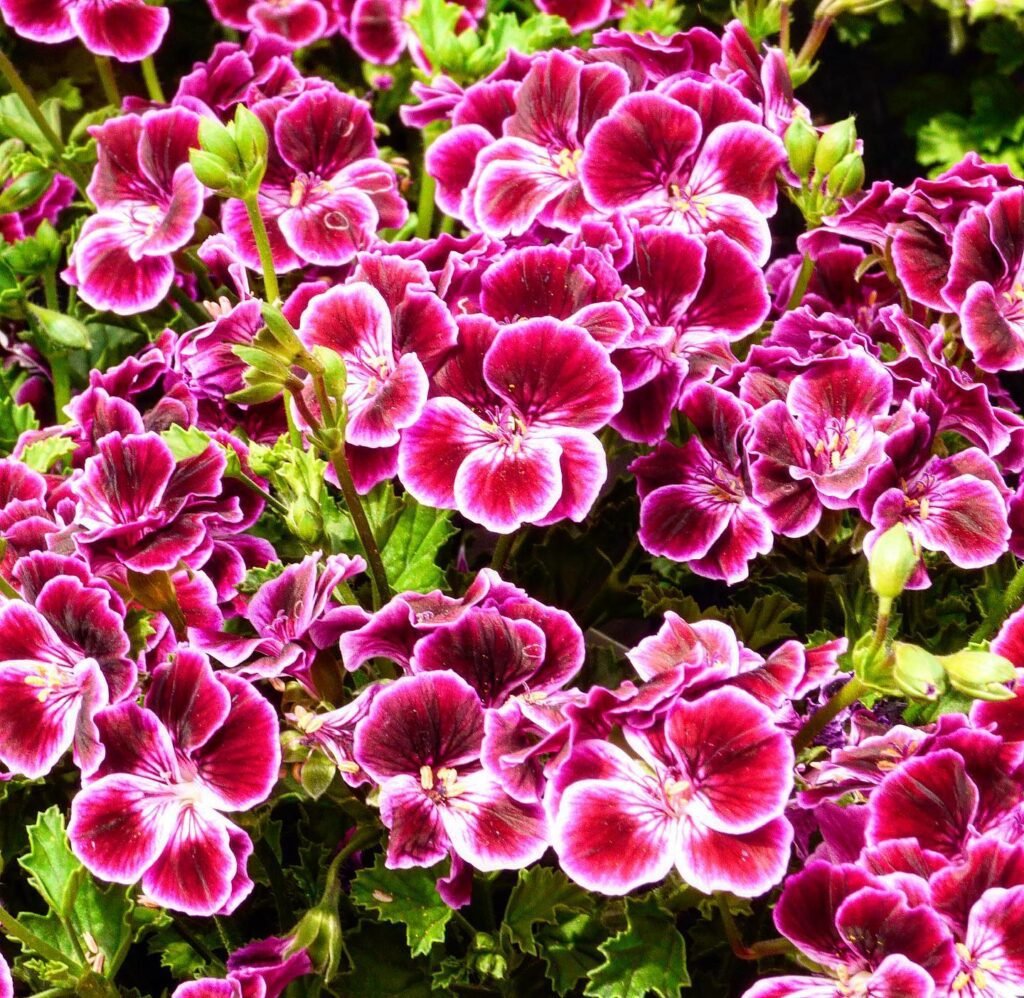

If you’re looking to expand your collection of lemon-scented geraniums or share the joy of this fragrant plant with friends and family, propagating Pelargonium crispum is a simple and rewarding process. There are two main methods for propagation: softwood cuttings and seeds.
Softwood Cuttings
- Choose healthy stems from the lemon-scented geranium plant.
- Remove the lower leaves, leaving just a few sets of leaves at the top.
- Place the cuttings in a glass of lukewarm water, making sure the stems are partially submerged.
- Keep the glass in a bright location, but not in direct sunlight.
- Change the water every few days to prevent stagnation.
- After a few weeks, you should start seeing root growth.
- Once the roots are around an inch long, it’s time to plant the cuttings in a well-draining potting mix.
- Water the newly planted cuttings and place them in a location with indirect sunlight.
- Continue to care for the young plants as you would with mature lemon-scented geraniums.
Propagation from softwood cuttings allows you to create new lemon-scented geranium plants that are genetically identical to the parent plant. It’s a reliable method that ensures you’ll have more of these delightful scented gems to enjoy.
Propagation from Seeds
If you prefer to start from scratch and witness the entire growth process, propagating Pelargonium crispum from seeds is also possible. However, it’s important to note that the resulting plants may not be identical to the parent plant.
- Collect ripe seeds from the lemon-scented geranium plant.
- Place the seeds in a seed tray or small pots filled with a well-draining potting mix.
- Lightly cover the seeds with a thin layer of soil or vermiculite.
- Maintain a consistent level of moisture in the soil by lightly misting it or using a spray bottle.
- Keep the seed tray or pots in a warm and bright location, but avoid direct sunlight.
- Germination usually takes around 2 to 4 weeks. Be patient and keep the soil consistently moist during this time.
- Once the seedlings have developed a few sets of true leaves, they can be transplanted into larger pots.
- Continue to care for the young plants and watch them grow into beautiful lemon-scented geraniums.

Repotting Tips for Lemon-scented Geranium
Lemon-scented geraniums are delightful plants that require repotting every two years in the spring. This process ensures their continued growth and health. Follow the step-by-step guide below for successful repotting:
- Choose a pot that is slightly larger than the current one. This will allow the roots to spread and accommodate the plant’s growth.
- Ensure that the chosen pot has adequate drainage holes. Good drainage is essential for preventing waterlogging and root rot.
- Fill the pot with a well-draining potting mix. A mix specifically formulated for indoor plants or herbs will provide the necessary nutrients and moisture retention.
- Gently remove the lemon-scented geranium from its current pot. Be careful not to damage the roots or stem.
- Place the plant in the new pot, ensuring that the root ball is covered with soil. Leave some space at the top to allow for watering.
- Press the soil gently to secure the plant and eliminate any air pockets.
- Water the plant thoroughly after repotting. This will help settle the soil and provide essential hydration for the roots.
Remember to place your repotted lemon-scented geranium in a suitable location with adequate sunlight and temperature. With these repotting tips, your lemon-scented geranium will continue to thrive and fill your space with its delightful fragrance.
Caring for Lemon-scented Geranium in the UK
To care for lemon-scented geranium in the UK, it’s important to provide it with the right conditions to thrive. This includes choosing a sunny location or partial shade that receives at least 4 to 6 hours of sunlight per day. The plant does well in well-drained soil that is neutral to alkaline in pH.
Regular watering is essential for the health of the lemon-scented geranium. Water the plant thoroughly, ensuring that the soil is evenly moist but not waterlogged. Allow the top inch of soil to dry out between waterings, as overwatering can lead to root rot.
Fertilize the lemon-scented geranium during the growing season to promote healthy growth and abundant blooms. Use a balanced liquid fertilizer every few weeks, and switch to a high potassium fertilizer when the plant starts flowering. Be cautious not to overfertilize, as this can result in excessive leaf growth and a decrease in fragrance.
Pruning is not necessary for the lemon-scented geranium’s growth, but it can be done to encourage bushier growth. Pinch back the tips of the shoots in spring or early summer. Additionally, remove any spent flowers to encourage continuous blooming. Regularly check the plant for yellow or dying leaves, and promptly remove them to maintain the plant’s overall health.
As a tender plant, lemon-scented geranium is sensitive to frost. If you live in an area with cold winters, it’s important to protect the plant from frost. You can either bring it indoors or cover it with a frost cloth to safeguard it from extreme temperatures.
 The lemon-scented geranium (Pelargonium crispum) is famed not only for its citrusy scent but also as a mosquito deterrent. Ideal for summer evenings outdoors or near windows, its fragrant leaves are also perfect for scenting oils and potpourris at home.
The lemon-scented geranium (Pelargonium crispum) is famed not only for its citrusy scent but also as a mosquito deterrent. Ideal for summer evenings outdoors or near windows, its fragrant leaves are also perfect for scenting oils and potpourris at home.
Benefits of Growing Lemon-scented Geranium in the UK
Growing lemon-scented geranium in the UK offers a range of benefits that make it a popular choice for gardeners. Here are some of the advantages of cultivating this delightful plant:
- Refreshing Fragrance: Lemon-scented geranium adds a pleasant lemon aroma to your garden or windowsill, creating a refreshing and invigorating atmosphere that can uplift your mood and senses.
- Compact Size: With its compact and bushy growth habit, lemon-scented geranium is well-suited for small spaces like balconies, patios, or windowsills. It can bring a touch of nature and fragrance even in limited areas.
- Culinary Uses: The fragrant leaves of lemon-scented geranium are popular for their culinary applications. They can be used to infuse teas, impart a lovely lemon flavor to desserts, or enhance the aroma of homemade potpourri.
Varieties of Pelargonium Crispum (Lemon-scented Geranium)
Pelargonium crispum, affectionately known as the lemon-scented geranium or lemon geranium, graces us with a selection of varieties, each boasting unique traits. This diversity allows the discerning gardener or windowsill botanist to select the perfect specimen to suit their aromatic and aesthetic desires.
- ‘Lemon Crisp’
- The ‘Lemon Crisp’ variety stands out for its powerfully fragrant leaves, offering an invigorating lemon aroma that’s both strong and enduring. It’s the go-to choice for anyone yearning for a robust, lasting citrus fragrance to invigorate their garden space.
- ‘Variegatum’
- For those seeking both scent and visual appeal, ‘Variegatum’ presents an exquisite option. Its leaves are strikingly variegated, featuring a charming blend of green and white patterns. This variety not only enriches the garden with its lemony scent but also adds a splash of decorative flair.
- ‘Lemon Fizz’
- ‘Lemon Fizz’ is celebrated for its softer, more subtle lemon fragrance. This variety is ideal for gardeners who appreciate a gentler scent, offering a delicate lemon aroma that enhances the garden’s ambience without overwhelming the senses.
- ‘Prince of Orange’
- Another delightful variant, ‘Prince of Orange’, emits a unique citrus aroma with a hint of orange zest. This variety’s leaves possess a slight orange hue, making it a visually appealing addition that brings a nuanced fragrance profile to the mix.
- ‘Golden Lemon’
- The ‘Golden Lemon’ variety is noted for its bright, golden-yellow foliage that catches the eye. Its scent is distinctly lemony, with an added layer of sweetness, offering both visual beauty and a fragrant delight to any setting.
- ‘Minty Lemon’
- For a twist on the traditional lemon scent, ‘Minty Lemon’ combines the fresh aroma of lemon with a minty undertone, creating a refreshing and invigorating scent. Its leaves are lush and green, adding a vibrant touch to the plant’s overall allure.
Whether your preference lies in the intensity of the lemon aroma, the subtlety of the fragrance, or the decorative appeal of the foliage, the various varieties of Pelargonium crispum cater to a wide range of tastes and garden designs. Each brings its own unique character to the garden or home, inviting you to select the one that best fits your aesthetic and olfactory preferences.
Helpful Videos about Pelargonium Crispum (Lemon-scented Geranium)
I’ve found some great videos online to help with caring for Pelargonium crispum, the lemon-scented geranium. These videos are perfect for beginners, showing simple ways to keep your plant healthy and happy. They make looking after the lemon-scented geranium easy to understand and follow.
Frequently Asked Questions about Pelargonium Crispum (Lemon-scented Geranium)

Wondering how to care for your Pelargonium crispum, the enchanting lemon-scented geranium? Dive into my straightforward FAQ for essential tips on nurturing this delightful plant. I’ve compiled advice on everything from the perfect lighting to the right watering schedule and overall care, ensuring your lemon scented geranium stays healthy and vibrant.
Pelargonium crispum, commonly known as lemon-scented geranium, is a plant known for its citrus-scented leaves and is often grown for its aromatic and ornamental value.
It thrives in full sun to partial shade. Aim for at least 4-6 hours of sunlight daily for optimal growth.
Yes, they can be grown indoors. Place them near a window where they can get plenty of light.
Use well-draining, fertile soil. A mix of garden soil, compost, and a bit of perlite or sand works well.
Water when the top inch of soil feels dry. Avoid overwatering to prevent root rot.
Yes, feed them with a balanced liquid fertiliser every few weeks during the growing season.
No, they are not frost-tolerant. Bring them indoors or protect them when cold weather threatens.
Prune in spring or summer to shape the plant and encourage bushier growth. Use clean scissors to snip off any leggy or dead stems.
Keep an eye out for aphids and spider mites. Use insecticidal soap or neem oil to manage infestations.
Yes, they can be easily propagated from cuttings. Snip a stem, remove the bottom leaves, and plant it in moist soil.
They can reach up to 0.5 meters in height and spread.
They produce pale pink flowers from spring to autumn, though they are mainly grown for their scented foliage.
Choose a pot one size larger than the current one. Gently remove the plant, place it in the new pot with fresh potting mix, and water well.
Yellowing leaves can be a sign of overwatering or poor drainage. Ensure the soil is well-draining and let it dry out slightly between waterings.
Yes, the leaves can be used to flavour desserts, jellies, and teas. Always wash the leaves thoroughly before use.
Reduce watering and ensure it gets enough light, possibly supplementing with a grow light if natural light is insufficient.
It might need more sunlight or fertiliser, especially a high-potassium one to encourage blooming.
While they can tolerate partial shade, they won’t be as vigorous and may produce fewer scents. For best results, provide them with plenty of sunlight.
If your plant becomes leggy, it’s likely due to insufficient light. Move it to a sunnier spot and prune back the leggy stems to encourage bushier growth.
I hope this makes looking after your Pelargonium crispum, or lemon-scented geranium, a bit clearer. If you’ve got questions, just ask in the comments – I’m here to help. Remember, every gardener starts somewhere, and there’s always more to learn about your plant. Happy gardening!

